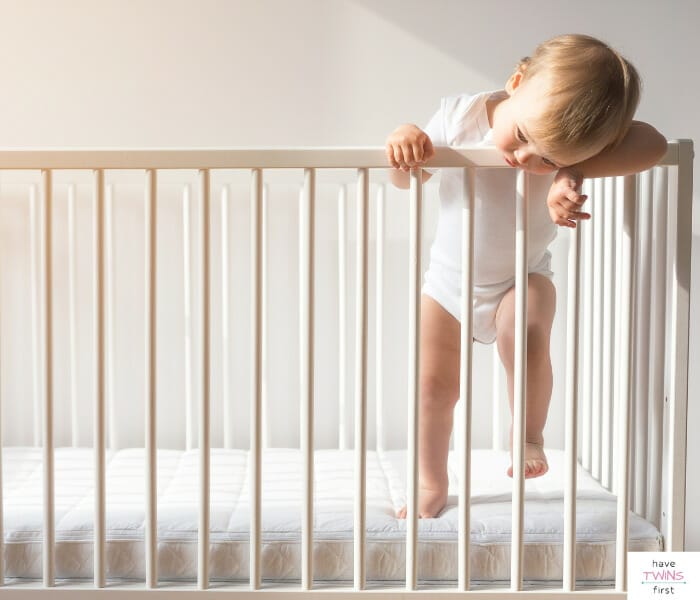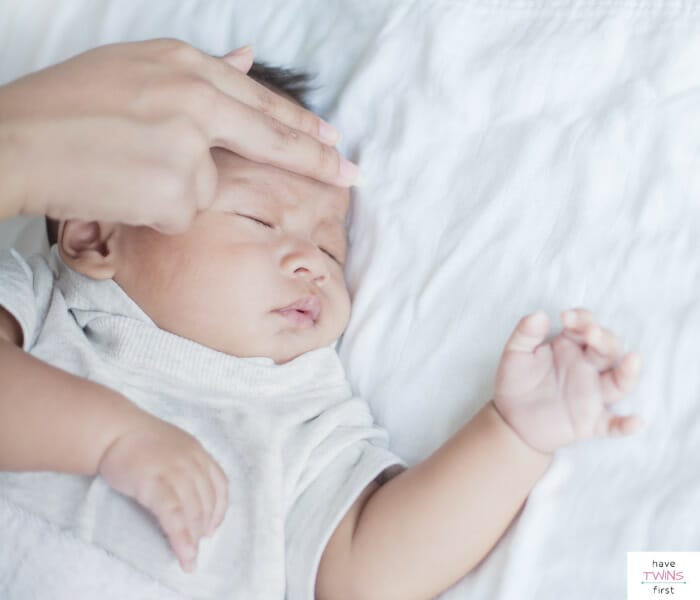Last updated: June 11, 2024
Have you heard that it’s important to put your baby down to sleep while he or she is still awake? As a mom of 3, when my twins were born I started hearing about this concept.
I ended up putting my babies to sleep while still awake, but drowsy, so that they did not get too used to being held to go to sleep. I found this to be very effective for helping my babies sleep as they grew throughout their first year of life.
That’s why in this article I want to share with you when to start putting a baby down awake and how to do it successfully. Let’s get started with discussing when you can start putting your baby down to sleep while still awake.
Please note, there are affiliate links in this post. Read my privacy & disclosure policy at the bottom of this page to learn more.
What Does Drowsy But Awake Mean?
The phrase ‘drowsy but awake’ means putting your baby down to sleep before he is sleeping soundly. If a baby is an independent sleeper, it means he will not need help to fall asleep and also not need help to go back to sleep. He can soothe himself and fall asleep without intervention.
Learning how to fall asleep on their own is a useful life skill to teach infants. If you try putting your baby down and it does not work out, you should not stop trying. Remember, consistency is the key.
One day your baby will get the hang of it and learn to fall asleep after being put down while still awake. Soon enough your little one will be capable of self-soothing in his crib and will sleep happily in his own space every night.
When To Start Putting Baby Down Awake
You can start putting your baby down awake as early as the newborn stage. If your baby cries a little bit before settling, there is nothing to worry about. Give him a few minutes before picking him up again. On the other hand, if your newborn is screaming for more than 5 minutes then you will want to check on him and soothe him.
If your baby is older than a newborn, you should start putting your baby down while still awake ASAP. For babies that are at least 6 months old and not sleeping well, you might be at the point where you want to try sleep training. If that’s the point you are at, I recommend checking out the Ferber sleep training method.
How To Put a Baby To Bed While Awake
It is a great idea to put your baby to bed while awake but drowsy. It gives your baby a chance to associate falling asleep with being in his own sleeping quarters (i.e. crib or bassinet). To ease the process of self-soothing for your baby, here are a few tips that you should follow before you put your baby to bed.
1 – Look For Signs Your Baby Is Drowsy
If your baby is showing these signs, it’s time to get him dressed for sleep and put him down to fall asleep on his own.
- Yawning
- Rubbing eyes
- Crying / fussy
- Closing eyes
- Pulling at ears / making fists
2 – Set The Mood
A dark, peaceful environment can help encourage your baby to sleep. Pay close attention to the colors, lighting, and temperature. Some items that help set this mood include nursery blackout curtains or shades, a sound machine, a night-light, and a crib mobile.
3 – Have a Reliable Routine
Follow the same easy baby bedtime routine every day. This might include feeding your baby, appropriately dressing your baby for sleep, reading stories, and singing lullabies. Over the course of a few days your little one will start associating this routine with going to sleep.
4 – Be Consistent
Follow a schedule each day. This includes naps, eating, playtime, and bath time. Be consistent with this schedule. Understanding baby awake time windows by age is super helpful.
When your baby is a newborn, the schedule will be less reliable. But as your baby gets older, he will become familiar with his schedule. If you follow the same routine each day, eventually your baby will have a predictable schedule around 3 to 4 months old.
Related: Baby Sleep Schedules for the entire first year!
5 – Ensure Safety
Make sure to place your baby on his back for sleep. Clear the crib of blankets and soft toys to prevent choking or any other risks.
Putting Baby Down Awake For Naps
Whether you are putting your baby down for a nap or for bedtime, you will want to put him to sleep while still awake. Follow the same routines described above at nap time too.
Plus, think of nap time as extra practice for your baby to get the hang of falling asleep on his own. This is actually the best time for you to try putting your baby down awake.
Naps are during the day, so you are not as tired yourself. This is a more productive time to focus on your baby’s sleeping habits.

What To Do When Putting Your Baby Down Awake But Drowsy Doesn’t Work
Here are some tips and things to check if putting your baby to sleep while drowsy, but still awake, is just not working out for you.
1 – Check If Baby’s Sleep Habits Are Age Appropriate
For newborns, sleepless nights and unreliable sleep schedules are very common. But, this is still the best time to start teaching your baby to fall asleep without being held.
Babies do not have a regular sleep pattern until approximately 4 months of age. The good news is many babies start sleeping through the night when they are 3 to 4 months old. This is especially true if parents have encouraged good sleeping habits, like having a simple baby bedtime routine, during the newborn stage.
If your baby is over 6 months old and his schedule is still not established, now is a great time to work on a sleep routine. After 6 months, your baby is old enough to sleep through the night and to try sleep training, if needed.
2 – Ensure the Correct Sleep Environment and Baby Sleepwear
A quiet, calm, and dark sleeping environment is important to help your baby fall asleep. Additionally, dressing your baby in appropriate sleepwear is vital too. My preferred sleep gear by age is as follows:
- Newborn – 3 months: Swaddle blankets
- 3-6 months: Baby Merlin sleepsuit
- 6+ months: Cotton sleep sack
3 – It’s Okay For Your Baby To Cry A Little Bit
Some babies find it harder to sleep on their own. For them, it might involve some crying and fussing which is a quite normal part of learning this sleeping skill. Do not pick your baby up immediately from his crib if he starts crying.
It is completely normal for babies to cry before and even during sleeping. Depending on their age, letting babies cry a little bit is okay.
Sometimes babies do fall back asleep on their own. This then teaches them how to self-soothe, even in the middle of the night. Just keep in mind it is not okay to let your baby cry for hours on end without checking on him.
4 – Stop Bad Sleep Habits
If your baby is older than 3 months avoid rocking, holding, or co-sleeping with your baby until he falls asleep. I know it’s very tempting in order to get some sleep, but in the longer term it will be worth it because both you and your baby will be able to sleep independently through the night.
5 – Get More Educated on Baby Sleep
If you feel like you have tried everything and just don’t know what to do, then I highly recommend the Baby D.R.E.A.M. System. The Baby D.R.E.A.M. System was created by a mom of 3 and certified pediatric sleep consultant specifically to help parents whose babies are crying at night.
You will learn how to start routines, provide the best sleeping environment, adjust sleep times, and implement sleep training. All things you need to know how to do in order to put your baby to sleep while still drowsy.
Learn More About the Baby D.R.E.A.M. System
Are you ready to try putting your baby down awake but drowsy?
Teaching your baby how to fall asleep on his own is a great skill. You might have been surprised to learn that you can start putting your baby down to sleep while awake from the time you bring your baby home from the hospital.
Putting a baby down while awake, but drowsy, can be beneficial for the overall health and development of an infant. It helps him learn how to be a good, independent sleeper.
Before I sign off, just remember that whatever baby sleep decision you make for your baby, it is very likely best for him. You are the parent and you have the instincts to know what is best. Best of luck as you navigate when and how to start putting your baby down to sleep while still awake.







